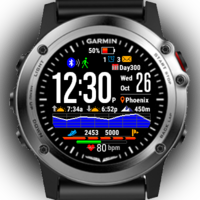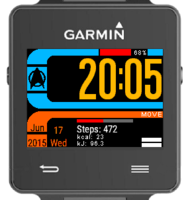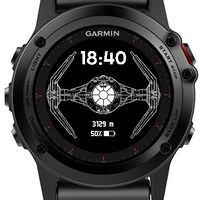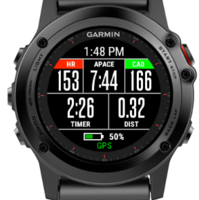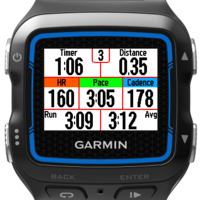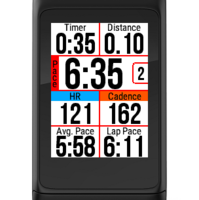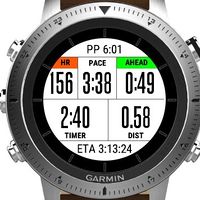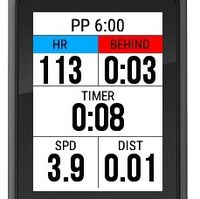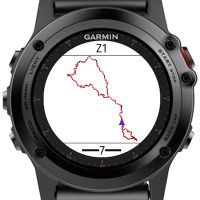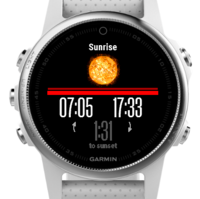Garmin Connect IQ
Garmin's Connect IQ allows for the creation of apps to run on Garmin's running watches in much the same way you can run apps on Android or and iPhone. This makes the newer Garmin running watches as revolutionary as the first iPhone. Before Apple introduced the iPhone, a smart phone was largely limited to the functionality that was provided by the manufacturer. Now there is a huge portfolio of applications that allow the iPhone to be used in new and novel ways. So far, we've seen a huge explosion in the number of apps available for Garmin watches, and this has dramatically improved the functionality, especially in the lower end watches like the Garmin Vivoactive that were a little crippled out of the box. It's not reached the point where seeing with smart phones, where they are primarily a platform for the apps with the phone functionality as a secondary feature, but it's not inconceivable that this might happen to running watches.
Contents
1 App Types
The Connect IQ platform provides for four different types of app; watch faces, data fields, apps, and widgets.
- Watch Faces. Each watch face can customize the default display, providing far richer information. Some of the watch faces available are simply prettier, while others cram on fast amounts of data, but my favorite watch faces provide insight into my recent training.
- Data Fields. These data fields are displayed during a workout, and are probably the most valuable for many runners. In addition to the obvious functionality of displaying data, a data field can also record new information into the FIT file, and can be customized by the runner using either the mobile app or the PC software. While there is a huge variety in the various data fields available, I would group them into these broad categories:
- Visual Data. A data field can be used to display data graphically, such as a graph of heart rate, or to color code the current value to provide faster feedback.
- Calculated values. A data field can display a new type of data such as Relative Running Economy.
- Sensor integration. A number of Running Sensors have used a data field to integrate with the Garman Connect IQ watches. For instance, Stryd uses a data field to display their estimate of running power as well as recording extra metrics such as Ground Contact Time.
- Single Field Display. There are several really useful data fields that are used as a single Field, taking over the entire watch face and displaying far more data than is possible by default. This is particularly useful in some of the lower end watches like the Garmin Vivoactive that only support three fields out of the box. With the right data field, it can now support five data fields, plus time and battery level.
- Watch Apps. The watch apps are intended to function as a workout type, or similar "full function" software. They handle all button presses, data recording, and display. I think that apps might have the greatest long-term potential, but they're also the toughest to develop. Most of the watch apps I've tried have been underwhelming. (Sometimes Garmin refers to watch apps as "applications", or even just "Apps" which creates a bit of ambiguity and confusion.)
- Widgets. A widget is accessed by scrolling up and down from the watch face, and they are intended to be much lighter weight than a full app. There are intended to provide information at a glance, and they can't record data or integrate with external sensors.
2 Favorite Watch Faces
There are a few watch faces that I've come to really love. The first two provide a graphical display of your activity over the last week. This allows you to see how your training is progressing at a glance, and can provide some additional inspiration to keep you moving.
3 Favorite Data Fields
There are a lot of great data fields out there, so I will mention just a couple of highlights.
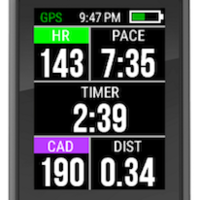 Here's the same field on the Garmin Vivoactive HR, where it's even more useful given the Vivoactive watches are crippled to only displaying three fields. | |
4 Favorite Watch Apps
I've not found any compelling watch apps so far. In the early days of Connect IQ there were a number of watch apps created because that was the only way of recording additional data. With later releases of Connect IQ, a data field can record additional data, so these apps are no longer needed. You can see this with Stryd, which was initially released as an app, but now you're better off with the Stryd data field. To me, the watch app that embodies the potential of this approach is "dwMap" by mappicus. This watch pants the functionality of following preloaded course is to the more basic watches like the Garmin Vivoactive.
5 Favorite Widgets
So far, widgets have been even less impressive than watch apps. There are some limitations on what data the widgets can access, which may be why they're not as innovative as I'd have hoped. For instance, a widget can't get a list of all of your activities to evaluate your training history. Let me know if you've found a widget that you'd recommend.
6 Connect IQ Limitations
Garmin are continuing to actively develop Connect IQ and expand its capabilities. There are a few limitations that have annoyed me and I feel are worth mentioning.
- So far, the Garmin watches can only have two data fields active for any given workout type. That makes sense, as you don't want the functionality to slow down or impair the functionality of the watch, but two is rather a low number. (The Garmin 735XT supports 3 fields.)
- There's no access from a data field to the data from Garmin's Running Dynamics, which I think would be a valuable source of data for calculated values.
- You can't access Heart Rate Variability data from a data field.
- Watch Apps operate in a low-power mode that restricts their functionality and refresh rate.
7 Connect IQ and Suunto Apps
While Suunto supports downloadable "apps", this should not be confused with Connect IQ. Without going into the technical details, Suunto supports simple scripts where Connect IQ is a full development environment. An analogy would be the difference between a programmable calculator and a PC. You can do some interesting things with a programmable calculator, but nothing like the things you can do with a PC.

